Last week I attended Pioneer Nation, a 3-day conference of solopreneurs and location independent entreproducers, organized by the same folks who put on the World Domination Summit.
When I attended WDS last year I realized what Chris Guillebeau had done by bringing this community together: he gave us a digital guild.
Before WDS, I was just a solo freelancer out in the jungles of Central America. Other than the international contractors I managed on Elance, and the clients I had weekly Skype calls with, my collaboration with my peers was practically zero.
Now, there is a guildhall.
** All photos on this post courtesy of Chris Guillebeau **
Speakers and Workshops
Chris Brogan
@chrisbrogan
When Chris Brogan rolls into town, you know it’s a big deal.
He double-booked the weekend, so after his keynote he had to dash off for another keynote in another city.
Ah, to have those problems.
“I’m a pioneering hipster, bitches.” Boston vs #PDX by @chrisbrogan #pdxpioneer
— Caelan Huntress (@caelanmac) March 27, 2014
Since Chris is from Boston, his pioneer blood runs deep.
Since he’s speaking in Portland, he can double-goad us by calling himself more hipster.
I have seen Chris uses this derailing tactic in his email newsletter to interrupt us from what we were thinking about.
He knows how to get attention in inboxes, that’s for sure. And since he also has some of the biggest email lists on the planet, he also knows a thing or two about cultivating a community.
“Business is about belonging. I want you to be embedded in the communities you serve.” @chrisbrogan #pdxpioneer — Caelan Huntress (@caelanmac) March 27, 2014
Nathan Barry
@nathanbarry
Nathan is the kind of teacher we all aspire to be. He is honest and candid about how much he knows, curious about what he doesn’t know, and willing to share what he’s found out.
“I became determined to teach everything I know.” @nathanbarry #pdxpioneer — Caelan Huntress (@caelanmac) March 27, 2014
What sets Nathan apart is that he understands where to put the paywall. By giving away lots of free material on his blog, he can put up a landing page for an ebook that he hasn’t even written yet. Measuring signups will allow him to gauge interest.
When he writes and publishes an ebook, he has a fantastic launch strategy, that has been learned by failing really big. (Failure turns into a recurring theme, with independent entrepreneurs, I am relieved to see.)
Jen and Omar
@thesearethings
The designers behind the wonderful guide Designed to Sell show us how they found something that worked for them, after lots of false starts and failures.
Their failures, it must be noted, are essential stepstones on the path to success.
Say yes to failure! @thesearethings #pdxpioneer
— Caelan Huntress (@caelanmac) March 27, 2014
Laura Roeder
@lkr
Laura Roeder is a powerhouse of social media marketing. She has worked with some of the biggest names in the world, and runs a seven figure business from London.
Her workshop revealed the simple mistake most of us are making in our business: most people are missing a marketing plan, or a marketing calendar.
This simple document can be used to plan what you’re doing, and when you’re doing it.
“A bad plan is so much better than no plan.” @lkr #pdxpioneer
— Caelan Huntress (@caelanmac) March 27, 2014
The marketing calendar schedules two things: the day in, day out posting on social media and your blog, and special offers or promotions you want to run at specific points in the year.
What I like so much about a marketing calendar is all of the planning is done in advance, so when it is time to produce, you just sit down and crank out the work.
Laura asked us for examples of promotions that have worked for us in the past. The audience replied with Instagram contests, value-add giveaways, and limited time promos to partner audiences.
“Keep doing what works, stop doing what doesn’t.”
When something works well, Laura said, put it in your marketing calendar and put it on repeat.
When something doesn’t work, delete it! Redirect the page. Say goodbye. Forget it, it never happened.
(This advice was really useful for me after my experience on the Hot Seat.)
Shenee Howard
@heyshenee
Shenee has a brand that is full of spunk and personality. She gave a fantastic workshop on “Expanding Your Business: Get Customers to Spend More.”
The throughline of her presentation was based on a simple, but powerful, premise:
“Your business is about meeting your target market at different points in their story.” – @heyshenee #pdxpioneer — Caelan Huntress (@caelanmac) March 27, 2014
During the workshop, we did more than just brainstorm the problems that our target market encounters; we made a timeline of the problems they encounter as they progress on their way to their ultimate goal.
There is always something they will buy, and if you can identify the key problems your target market will have, you can create offers and services that they will love.
Terry Starbucker
@starbucker
Terry Starbucker gave a workshop called “Pricing Strategy: What Should You Charge?” and it was full of the meaty, actionable advice that I was hoping to get out of this conference.
“You can sell less, and make more.” – @starbucker #pdxpioneer — Caelan Huntress (@caelanmac) March 27, 2014
How does one accomplish this? The easiest method:
“Do not underestimate the suggestive power of anchoring.”
An anchor is when you mentally tie your price to a number in the customer’s mind.
This is why rug salesman start by saying ‘That rug is too expensive for you, it is ten thousand dollars.’ Later, when you walk away with a rug for two thousand dollars, you think you have made a really good deal.
The anchor is one of three prices used in Bracketing – when you try to guide your buyer into the ideal price.
Price bracketing involves three prices for three different packages:
1. Offer a low price that is a decoy.
2. Your ideal price. (Make sure it ends in a 9.)
3. Your anchor price.
You may never have anyone purchase your anchor price, but that’s okay. The anchor gives your client a mental model of the value of your services.
He ended his presentation with this little gem: “If your product is expensive, make your website look expensive.”
Truth.
Rena Tom
@rena_tom
Rena is a perfect case study in how a polymath can follow multiple interests, and find success at their intersection.
“Generalists make very good entrepreneurs, because they can do everything under the sun.” – @rena_tom #pdxpioneer — Caelan Huntress (@caelanmac) March 28, 2014
“Move fast and break things.” – @rena_tom #pdxpioneer — Caelan Huntress (@caelanmac) March 28, 2014
Lori Allen
@gepublishing
How does a writer meet her goal to create a million dollar business? Like Lori did.
Lori hosts travel writer retreats. She gets everything setup, including customers, before moving any money.
“Once the money starts coming in, I sign all the contracts. Ready, fire, aim.” – @GEPublishing #pdxpioneer — Caelan Huntress (@caelanmac) March 28, 2014
This allows her to pivot without obligation if an event isn’t going to work. Very clever.
Chase Reeves
@chase_reeves
Chase is one of my heroes. He has an engaging on-stage personality, he does lots of funny accents, and he really knows his stuff.
He took the mainstage for a little while to talk about Fernet. This quirky drink was the reason he met one of his long-time collaborators, and he credits this Italian apertif with curing hangovers and skyrocketing his business.
His mainstage talk was super fun, but it was nothing compared to his workshop.
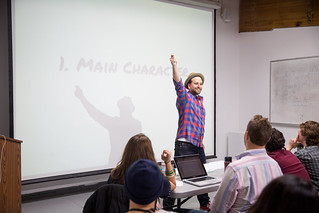 In the best stack of slides of the entire conference, he challenged us to unveil the hero of our business.
In the best stack of slides of the entire conference, he challenged us to unveil the hero of our business.
The character who wants something and overcomes obstacles to get it. The hero of our brand story.
Because a brand, after all, is just a story that makes someone care.
“Without the right story your brand stays boring. Boring is the enemy of a brand.”
Most people are bored by our business stories. (Where we talk about me. Me. Mememememememe. Mememe. Meme. Mememememe. Like I was doing in my newsletter, before the Hot Seat burned my pants off.)
To illustrate a better way to do it, Chase used a common cultural reference, Star Wars. 
This picture, Chase told us passionately, has the whole movie in it.
The whole story is right here. (Slightly amended.)
Obi-Wan is giving Luke his father’s lightsaber.
If this movie was our brand, who would be the hero? Who is the Luke Skywalker of our business?
“You are not the main character of your business. Your customer is the hero. You are Obi-Wan, the mentor, and you give them the gadget that will solve their problem.”
You don’t solve someones problems. They solve their problems. You just give them the tools they use to do it.
Your Mission Formula: Character + Desire + Stakes #pdxpioneer @chase_reeves — Caelan Huntress (@caelanmac) March 28, 2014
Marketing, he concluded, is telling someone about their problems in a better way than they can.
That is totally doable, so long as you are telling their story, and not your own. 
Andy Hayes
@andrewghayes
Andy Hayes provided a real work-heavy workshop. This was eyes down, pencils moving, write your ideas on paper, get it done work.
“Be where you are and start with what you have.” – @andrewghayes #pdxpioneer — Caelan Huntress (@caelanmac) March 28, 2014
We focused first on the ideal customer: who they are, and why you are the person for them.
I’ve done some work on my ideal client profiles before, but I’ve never taken the time to write their story.
This is the story I found during the workshop:
“Jenny the Juggler had an email address, and that’s it! She had [email protected] printed on all of her business cards, but she had no website. Parents would say to each other, ‘Yeah, we had this great birthday party performer for our kid’s party, and it was amazing! A 2-hour show with balloon animals and face painting, juggling and bunnies, here’s her card! Give her a call!’ Before calling, of course, they went to jennythejuggler.com and saw…nothing. So they never called. Jenny was losing business, so she built a quick and dirty website, and the code was bad and the website broke, so it got even worse; people were finding her online, and what they found made them not want to call her or hire her. The potential customers who found her outdated and broken website thought, oh, she must be out of business or something. Oh, well – and they called her competition. Jenny was losing business. She was losing potential customers. She needed an online setup that made her look professional, approachable, and available. So that’s what I made for her.”
When I put it like that, it sounds much more relatable and clear.
Cory Huff
@agoodhusband
Cory Huff helps artists make money selling their stuff. (Is that a well-defined niche or what?)
He took us through the basics of affiliate marketing.
The workshop was not about how to make money from selling other people’s products, but rather about setting up affiliates to sell your stuff.
“Clickbank is the red light district of affiliate programs.” – @agoodhusband #pdxpioneer — Caelan Huntress (@caelanmac) March 28, 2014
“This is where most affiliate programs fall down: you need a good conversion funnel.” @agoodhusband #pdxpioneer — Caelan Huntress (@caelanmac) March 28, 2014
Kari Chapin
@karichapin
Kari is not just a successful author and maker, she is also an expert in moving through fear.
“What is the risk you need to take in order to move yourself forward?” – @karichapin #pdxpioneer — Caelan Huntress (@caelanmac) March 29, 2014
Willo O’Brien
@willolovesyou
Willo O’Brien is the godmother of Pioneer Nation.
The first person Chris Guillebeau called to talk with about the idea, beyond the production team, was Willo.
She is super smart, has great design aesthetics, and works with creatives and independent entrepreneurs through her coaching practice.
Her understanding of our situations and trajectories is monumental.
“There is no greater journey of self discovery than running a business.” – @WilloLovesYou #pdxpioneer — Caelan Huntress (@caelanmac) March 29, 2014
“You’re not managing your time, you have to manage your #energy.” – @WilloLovesYou #pdxpioneer #timemanagement — Caelan Huntress (@caelanmac) March 29, 2014
“Your number one job is to keep yourself as happy and healthy as possible.” – @WilloLovesYou #pdxpioneer // Great speech! — Caelan Huntress (@caelanmac) March 29, 2014
Brian Clark
@brianclark
Brian Clark is a titan of the website world.
His website Copyblogger has grown to become the standard for content marketing on the web. Copyblogger Media is now a suite of solutions, from hosting, to theme design, to SEO.
(And now he’s doing coaching, too.)
What surprised me, and gave me comfort, was when he said this:
“I am basically unemployable. You get what I’m saying if you are in this room.” – @brianclark #pdxpioneer // We totally get it. — Caelan Huntress (@caelanmac) March 29, 2014
I totally got it.
I recently made a fantastic resume landing page, with a video cover letter and everything. Then I applied for hundreds of jobs, and I got zero calls from it.
Maybe, I realized, I’m not a very good candidate to be an employee.
After looking at Brian’s path to success, I figure, that’s probably okay.
“Stay at home. Write. Wear pants only if I wanted to. This is the life I wanted.” – @brianclark #pdxpioneer — Caelan Huntress (@caelanmac) March 29, 2014
Brian started as a lawyer, got into writing articles, and then worked with IDX feeds when they were new.
There were a lot of different things he tried, and when things started working, he did more of those things.
Then he hit me with the biggest lesson of the entire conference:
“I don’t do any part of the business except the part that I’m good at, and that has made all the difference.” – @brianclark #pdxpioneer
— Caelan Huntress (@caelanmac) March 29, 2014
 ** All photos on this post courtesy of Chris Guillebeau **
** All photos on this post courtesy of Chris Guillebeau **
Other people are writing about Pioneer Nation, too.
I’ve compiled a List.ly of all the blog posts, speakers slides, and relevant resources mentioned at #pdxpioneer. Feel free to add to the list below.
[listly id=”HUe” layout=”gallery”]
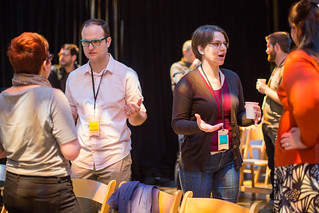
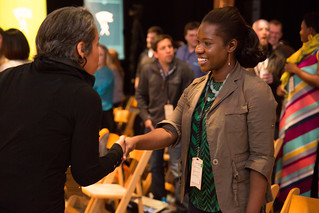


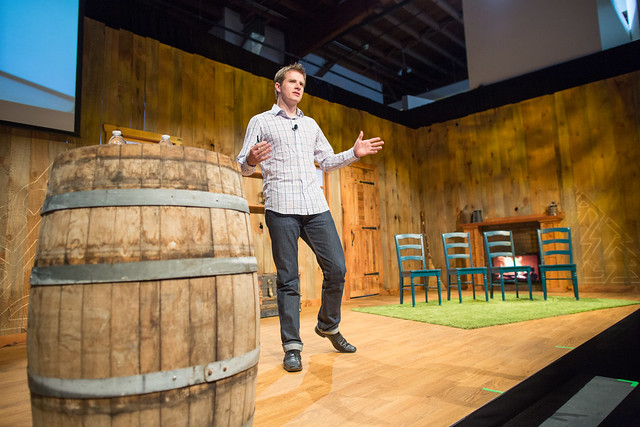
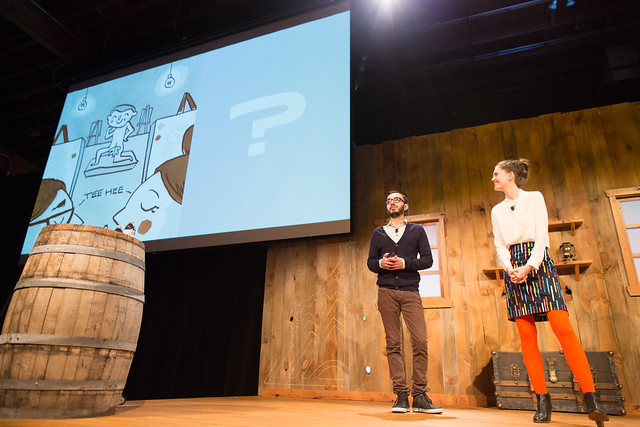
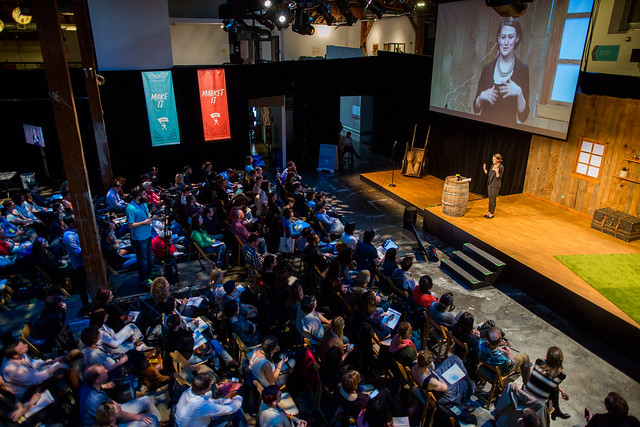

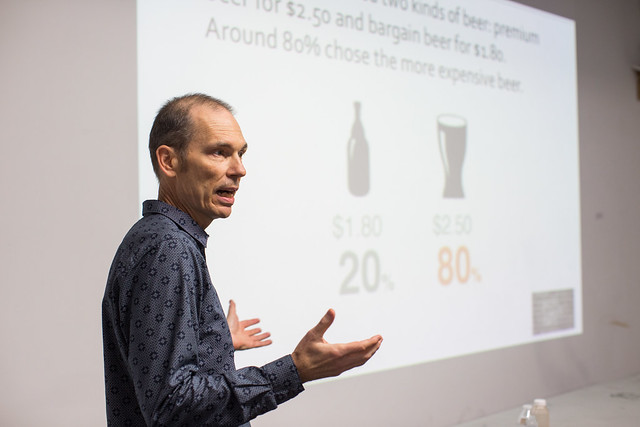
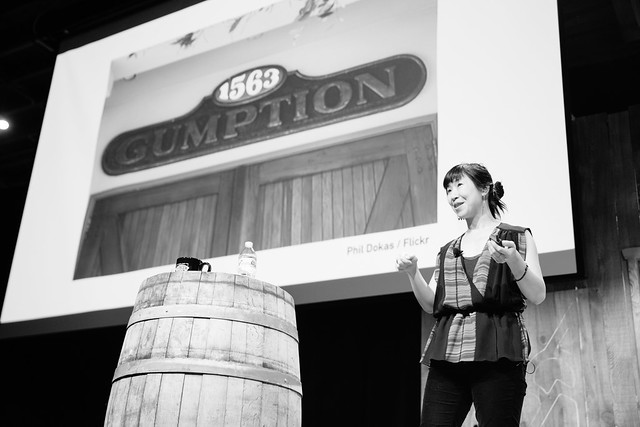
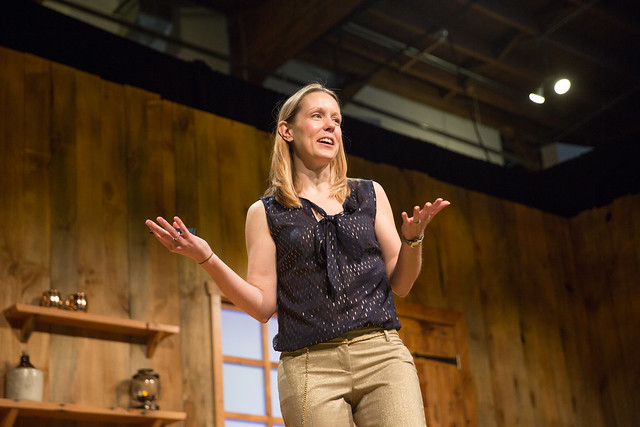


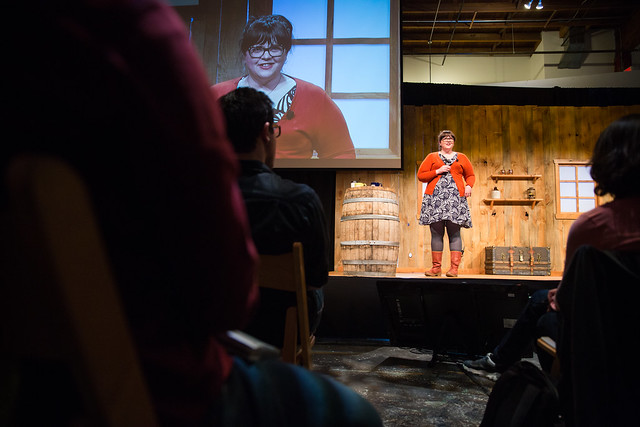
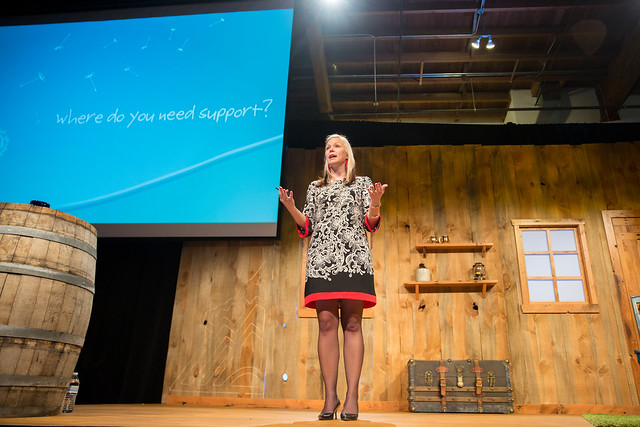


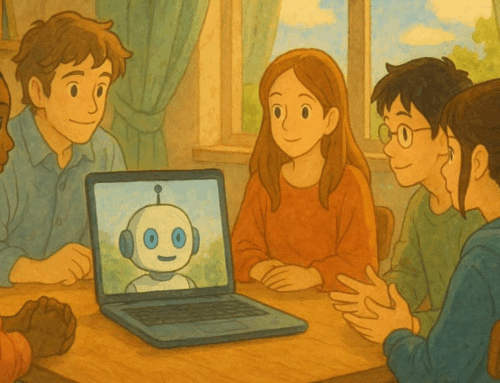

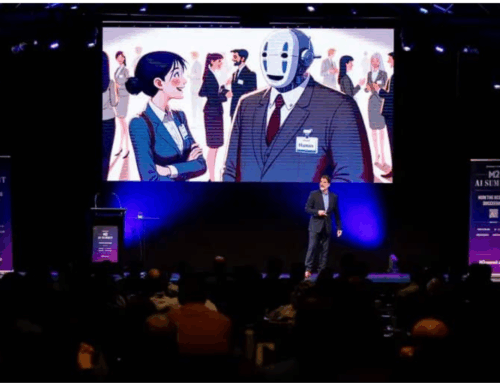

Whoa. Awesome Caelan.
Thanks, Chase! You were amazing. Let’s get lunch later this month.
Awesome! Great recap Caelan of a great event in Portland.
Great to meet you there, Neil!
Great job! I can see you put a lot of hard work to distil the best lessons from each speaker you saw. Hopefully you got a long list of next steps. Good luck!
I missed something important in this recap, Karl. I saw pictures of your Venn diagram floating around with a big ‘Superheroes’ label in the middle of the overlap. I didn’t get to see your workshop, did you post your slides online? I heard great things about it.
I found your slides on your blog, Karl, and put them on this list: http://list.ly/list/HUe-pioneer-nation-2014
If anyone else has slides or resources to share, head on over to the list!
[…] Caelan recaps his favorite moments and pictures […]
You are my hero for going up on stage. Balls of stell. Great meeting you! Great recap.
Mike
STEEL!
They clank when I walk, Mike. Great to meet you, too!
[…] I went to Pioneer Nation last month, there was a really inspirational story told by Laura Roeder. (It’s the first two […]
[…] been to both Pioneer Nations (you can read about Pioneer Nation 2014 – or how I broke my newsletter on the Hot Seat) and I’ve been to the last three years […]